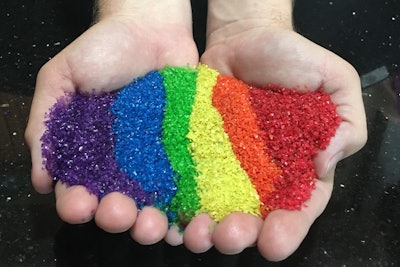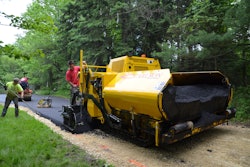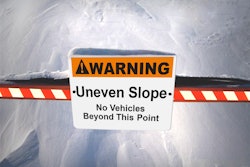
Speedy Striping is always on the lookout for unusual, cutting-edge or high-profile projects, so when Lucas Boring, president, learned about plans to paint four “rainbow” crosswalks in a major Tucson, AZ, intersection he knew he’d found all three criteria in one job.
The busy intersection of 4th Avenue and 6th Street is near the University of Arizona and is one of the main college drags for restaurants, bars and entertainment. Situated in Tucson’s historical district, the area is managed by the Historic 4th Avenue Merchants Association, which was a supporter and partner in the plan.
Boring says the idea for the rainbow crosswalks belongs to Adam Ragan, associate director of the LGBTQ initiatives of Southern Arizona Aids Foundation. “He came up with the idea of the rainbow crosswalks at that location and he worked on the project for four years,” Boring says. “He contacted me two years ago and I’ve been working on it ever since. I came up with the design for it, a custom-made product, and a unique production process.”
Speedy Striping donated planning, labor and equipment for the project. The supplier Ruby Lake Glass, Richfield Springs, NY, donated a portion of the material cost.
“We’re honored to share in a project that highlights the diversity of everyone in the Tucson community,” Boring says. “It took coordinating a lot of moving parts to do something like this dynamic.”
Self-taught Stripers
Boring and wife Patrice, project manager and office manager, started Speedy Striping, Tucson, AZ, in 2003 after working in the industry doing paving and sealcoating. Before then they had owned a variety of other businesses. “I’m serial entrepreneur,” he says.
The company, which employs 15 people in peak season, is a full-service striping contractor offering everything from parking lot striping, long-line striping, short-line road striping (intersections, crosswalks, stencils), athletic field and court striping, parking garage striping (see sidebar) and warehouse striping, traffic sign installation, and marking removal.
“We basically taught ourselves the business,” he says. “We started out at ground level knowing nothing and did a lot of research and took our time learning it. A lot of people learned from somebody and then they move forward. We started our businesses from the outside and worked our way in.”
He says they are constantly on the lookout for the best product, best equipment and best practices to do the best job.
Cutting-edge Company
In fact, they have designed or modified much of their equipment. “We do a lot of research and if we can’t find what we’re looking for we design it ourselves. Almost every piece of equipment we have has some kind of modification we’ve made,” he says.
Among their designs or modifications are:
- Laser guidance on long-line striping units.
- A customized road reflector (RPM) trailer. “We cut everything off of a standard trailer and redesigned it to have better ergonomics, better safety features and better lighting for us.”
- Glass bead dispensing system for walk-behind carts. “There’s always somebody standing around when you’re ready to start striping and we put them to work doing beading,” Boring says. “That gets him used to striping and helps develop the eye-hand coordination as they follow the stripes.”
- A colorization formula for the green extruded thermoplastic often used on bike and pedestrian safety zones.
Stained Glass Aggregate for the Rainbow
The rainbow crosswalks cross each street of the intersection, and because of the high-profile location the planners, along with Boring, wanted a bright look that would last for years. So Boring took on the task of finding the appropriate material. They considered paint but after inspecting other colored paint that had received high traffic volume they weren’t happy with the degradation of the colors, so they looked for something else.
“Other communities have tried colored paint but that ends up looking real bad within a month,” he says.
What they wanted was a very high-quality product that would not only stay clean but wouldn’t track – a potential problem in hot Arizona summers with little rain – and would remain bright. So instead of colored paint Speedy Striping used a traffic-grade epoxy laid by hand and covered with a layer of crushed colored glass aggregate.
“One thing we learned during the project is that you can really put within the crosswalks whatever you want as long as it meets the MUTCD and ASTM specs,” Boring says.“We opted for crushed glass because it is more durable so it would stay looking good for a long time. Because this is a high-profile project we wanted something that would last as long as possible. The colorized glass aggregate offers great vibrancy of color and also offers UV stability which is also important here in AZ.”
Boring says they matched the Pantone colors and Ruby Lake Glass stained the glass specifically for the job. In fact, for some colors Ruby Lake Glass had to blend two colors within the glass to get the exact color Tucson and Speedy Striping wanted. Boring says the glass product met MUTCD and ASTM specs for coatings that cover a broad surface near intersections.
Timing is Everything
Boring says because the intersection is so busy – one of the 10 busiest in the city – and because a streetcar comes through the intersection on a track, they had difficulty getting permission for a four-way closure – but they eventually got it. The Speedy Striping six-person team started work on a Sunday afternoon and worked 18 straight hours so the intersection could be opened for Monday morning traffic.
“A lot of work went into determining the schedule and timing each phase of the job,” Boring says.
Planning out how to install the rainbow crosswalks on four streets with as little disruption as possible was the first challenge Speedy Striping faced. There were four crosswalks with six colors (not including white) and work had to be phased with epoxy cure time and to keep production going.
“There were 24 unique phases – six colors times four crosswalks – and we timed out every part,” Boring says. Among the steps Speedy Striping timed out were:
- Mixing epoxy
- Squeegee application of epoxy
- Workability of the epoxy
- Placement of aggregate
“The challenge was having so many phases of epoxy cure time and keeping production going,” he says. “We timed all those things out for 24 cells so we could have steady production.’
Once on site crews examined the existing crosswalk, cleaned up the layout, straightening it out a bit, and then they got started. They taped off a reveal on the tracks to allow the streetcar to pass through, and they also created a 4-inch reveal as a transition from the crosswalks to ADA ramps, making sure access was provided according to ADA regulations.
Next they taped all sections of each crosswalk to create crisp lines for the colors.
Boring says the plan was to alternate cells going all around the intersection, first spreading the epoxy then placing one color glass on one cell, skipping a cell, and placing another color glass. Glass aggregate was supplied in 50-lb. bags and broadcast by hand across each section of epoxy. Boring says the crew paid close attention to the glass aggregate as it was being spread to make sure the epoxy was completely covered. “We made sure every bit of epoxy had a good bed of aggregate sitting on it,” he says.
“We then let it sit for the appropriate time, which varies depending on temperature and humidity,” Boring says. “And we had to keep a close eye on the epoxy too. We had to really watch the phase change and had to pull the tape off right away to get the clean edge.”
Then they broom swept the aggregate and then vacuumed the aggregate to remove any excess glass.
“What’s left behind is a vibrant, durable traffic product: recycled colored cut glass aggregate,” he says.
“Basically we went through and did a couple of colors, did recovery and cleanup on those colors, then started again and repeated the process,” Boring says.
Once all the rainbows were in place Speedy Striping painted the 12-in.-wide edges of the crosswalk and placed glass beads on the white paint, making the crosswalk compliant with MUTCD.
“It was really fun, really challenging and it really kicked our ass. But we enjoyed doing it,” Boring says. “Everything came out great especially since is the first time being done. People can’t believe how bright and vibrant the material in the intersection is.”



![Lee Boy Facility 2025 17 Use[16]](https://img.forconstructionpros.com/mindful/acbm/workspaces/default/uploads/2025/09/leeboy-facility-2025-17-use16.AbONDzEzbV.jpg?auto=format%2Ccompress&fit=crop&h=100&q=70&w=100)







![Lee Boy Facility 2025 17 Use[16]](https://img.forconstructionpros.com/mindful/acbm/workspaces/default/uploads/2025/09/leeboy-facility-2025-17-use16.AbONDzEzbV.jpg?ar=16%3A9&auto=format%2Ccompress&fit=crop&h=135&q=70&w=240)








